5 key facts about this project
The design exists within the rich landscape of viticulture, serving not only as a wine tasting room but also as a bridge between visitors and the local scenery. Positioned on a hillside, the building focuses on integrating with its surroundings. The overall concept highlights the relationship between the built environment and nature, aiming to foster a deeper appreciation of the vineyard’s cultural and geographical context.
Building Placement and Integration
Carefully placed down the hillside, the building maintains a low profile, ensuring that it does not obstruct the views of the surrounding vineyards. The design emphasizes blending in with the landscape, enhancing the overall experience for visitors. The wine tasting room is oriented as a passage, establishing a connection between the interior and the fields. This orientation allows guests to engage with the origins of the wine while enjoying the natural beauty around them.
Reflection and Connection
Reflective surfaces play an important role in the design, creating a connection between the outside and inside. Mirrors are strategically incorporated to bring the landscape into the space, enhancing the sensory experience for visitors. As people move from the outdoor plaza into the cool interior, they encounter a visual extension of the vineyard, deepening their appreciation for the natural setting.
Materiality and Sustainability
Materials in the design reflect the local culture and geology. Clay bricks, terracotta tiles, and lioz limestone from Sintra are used, all sourced from local producers. This choice supports the community and reduces environmental impact from transportation. The selection of materials also contributes to the structure's durability, ensuring it remains aligned with the landscape.
Structural Considerations
The building's roof features a groin vault, utilizing the strength of stone for support. This method eliminates the need for insulation, ensuring the structure remains integrated with its environment. The understated aesthetic is complemented by a pergola that extends the interior outward, creating shaded spaces for various activities and enhancing the connection to nature.
As the seasons change, the space evolves, allowing visitors to experience different aspects of the vineyard. The design creates an opportunity for guests to engage with the environment, providing a setting where the wine’s origins are celebrated and appreciated. This connection invites a deeper understanding of the viticulture process, encouraging meaningful interactions with the landscape.






















































